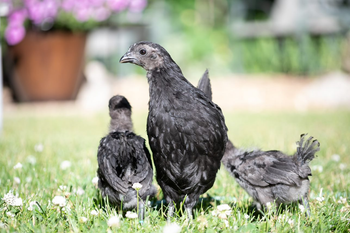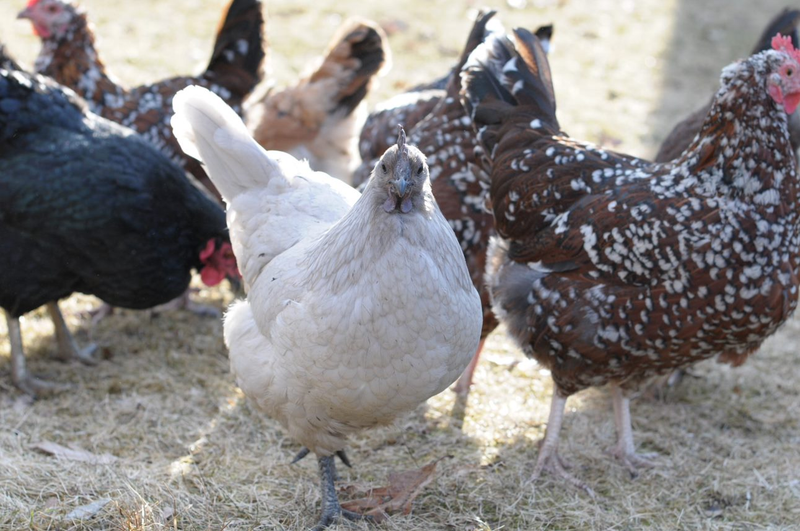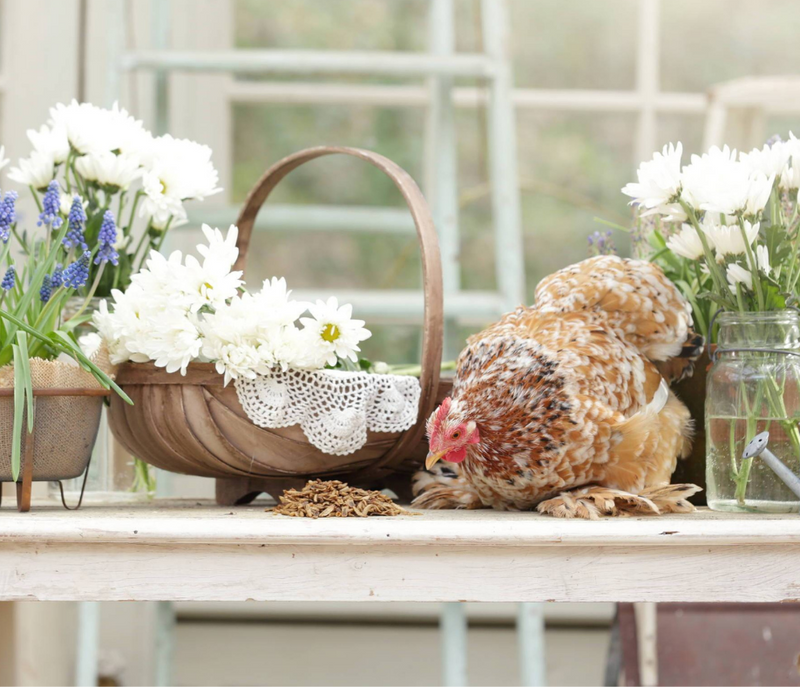Chicken math is real. If you’ve fallen for your feathered friends, it’s nearly impossible to not want to grow your flock by introducing new chicks or chickens. However, properly integrating new birds into the family requires a bit of know-how and time. This is because chickens have a rigid social structure, and when you add new birds to the flock, it destabilizes that structure. Unsure of how and when to let your chicks meet the rest of the gals? This guide will walk you through the process of introducing your new birds in a safe and proper way.
What Is Flock Integration?
Integration is the term used for the process of introducing new chickens to an existing flock. Many newer flock owners are surprised to learn that new hens, roosters, and chicks cannot simply be added to their flock without preparation and precaution. Instead, the integration process must be gradually deployed to the new chickens; current chickens have the greatest chances of a smoother transition.
New Chickens & the Pecking Order
A flock is governed by its pecking order, in which each member of the flock has a rank. This hierarchy allows your feathered family to coexist peacefully without fighting for resources. When you add new chickens to the flock, the new chickens need to find their rank in the flock’s pecking order and be accepted by the established flock members.
Why Proper Integration is Important
Backyard chickens are more than just egg producers–they’re a part of the family. Like other pets, keeping your chickens safe, healthy, and happy is a top priority. Adding chickens to a flock without proven integration techniques leaves your girls vulnerable to bullying, injury, and flock-wide disconnect.
Proper integration of new chickens into an established flock is important for:
- Pecking Order Adjustment: Integration helps a flock slowly adjust to a change in the pecking order.
- Preventing Segregation: Integration will prevent the new chickens from being segregated from the older birds, which can make for a divided flock that is at odds with each other.
- Reducing Bullying & Fighting: When new chickens are introduced gradually, they can be accepted by the flock without bullying or fighting.
- Preventing Bad Behaviors: Proper integration can help prevent unwanted behaviors (like sleeping in the nesting boxes) from developing when hens are under stress due to a pecking order change.
Common Issues That Arise from Improper Integration
When proper integration is not done, it can result in bullying and shunning of the new birds from the existing flock. This can lead to injury and veterinary bills while reducing the joy you receive from flock-keeping.
Additionally, improper introductions cause stress levels to rise amongst the old and new birds, which is not good for their health or laying productivity. Stress can lead to bad behaviors such as feather pulling, egg eating, bullying, and worse.
When to Integrate Chickens into an Established Flock

How to integrate new chickens into an established flock starts with knowing when good timing is for integration. However, there are certain scenarios that affect when you introduce new chickens into your existing flock. Consider which scenario best fits your situation to help you decide when the proper time is to integrate new chickens into your flock.
Scenario #1: When can you introduce chicks to the flock?
The scenario applies to young chicks you’ve raised to add to your flock. This situation can include both chicks you hand-raise yourself and chicks that have been raised by a mother hen.
Signs Your Chicks Are Ready
Young chicks need to be mature enough so that they are roughly the same size as the smallest member of your flock.
Baby chicks that are introduced to an adult flock too soon may get bullied, harmed, or worse if the older hens see them as intruders. Waiting until the young birds are similar in size to the adult flock allows their behaviors to mature and gives them the confidence to interact with the older chickens. Chicks should also be weaned off of supplemental heat before you consider integrating them into an older flock.
Waiting until young chickens are the proper size to be integrated into the flock also allows you to continue feeding them the proper diet they need for growing. If you integrate them into the flock too soon, they may start eating layer feed before they have reached reproduction age. Once young chickens have reached 18 to 20 weeks of age, they can be switched from a starter feed to a layer feed and may be big enough to be integrated into the flock.
Chicks Raised by a Mother Hen
When you let a mother hen raise a brood of chicks, it is usually best to separate her from the rest of the flock during the brooding period and as she raises the chicks. Once the chicks mature to the point where they are independent from their momma, you can re-integrate her back into the flock and begin planning for the little ones’ flock intro.
After the mother hen has been removed from the chicks, you will want to continue to raise them until they are old enough to join the adult flock. If you are looking to introduce young chicks to a broody mother hen, make sure you check out this article on How to Hatch & Raise Chicks Using a Broody Hen!
Scenario #2: Can I add adult chickens to my current flock?
This second scenario applies if you have bought mature or growing birds to add to your flock. Some hatcheries offer the option for you to buy pullets (or cockerels) that have reached reproduction age. You may also choose to buy birds from a breeder who is selling mature birds.
If you buy new, matured chickens who are ready to lay eggs and are the same size as members of your current flock, then they can be integrated almost immediately.
Quarantining New Chickens Prior to Flock Integration
However, before you integrate mature birds into your existing flock, you want to quarantine the new birds for a period of at least 2 weeks. A two-week quarantine period allows you to monitor the new birds for signs of disease or parasites that they could potentially introduce to your flock. Keep the new birds completely separate from your existing flock during their quarantine period.
If you see signs of sickness or parasites, you will want to treat the new chickens before integrating them into your flock. After 2 to 3 weeks, if the new chickens seem healthy and are parasite free, they can be integrated into your flock safely!
Scenario #3: Do I need to re-integrate a chicken who has been separated from the flock?
This last situation is if you had to remove a chicken from your flock for an extended period of time due to an injury, sickness, broodiness, or bullying. Hens who are high up in the pecking order can usually be removed and returned to the flock smoothly.
However, hens who are lower in the pecking order or who have been bullied will need to be re-integrated back into the flock after they have been absent for a while. How quickly re-integration goes will depend on how long the hen was absent from the flock and where she was previously in the pecking order.
How Long Does it Take to Introduce New Birds to the Flock?
How long it takes for new chickens to be integrated into your flock will depend on the breeds and personalities of both the new chickens and your flock. Some breeds will accept new flock members faster than others.
The Fundamentals of Adding New Chickens to Your Flock

Before your new girls ever lay eyes on their future flockmates, there are some guidelines you will want to know. While the method of integrating new chickens into an established flock can be done in several different ways, the main principles of integration will always stay the same.
Steer Clear of Molting Seasons Introductions
Avoid introducing new chickens to your flock during molting season (usually in the fall). Molting is stressful for hens as they focus their energy on growing new feathers. Introducing new chickens to the flock during the molt can result in even more stress. The minor squabbles or pecking that occurs during reintegration or integration will also not go over well with hens who have sensitive feather follicles where new feathers are growing in.
Cold Turkey Introductions Are a No-Go
Never place new birds or young birds into an established flock ‘cold turkey.’ This goes against all the principles of integration. Chickens need time to get to know each other. Adding new chickens to the flock takes time in order for the flock to adjust to a new social structure (pecking order).
Roosters Can Aid in Smooth Integrations
Having a rooster in your flock can also help integration go smoothly and faster. The rooster will be more accepting of the new chickens, and he will help prevent any fights as a new pecking order is established amongst the hens.
Integrate New Chickens in Groups
There is safety and structure in numbers. Avoid integrating just one or two birds at a time. Ideally, integrate chickens in groups of at least four birds or more.
New chickens will feel more secure and confident if they already have a mini pecking order established amongst their small group. Integrating multiple chickens at one time also reduces the chance that your flock will bully a single integrated chicken.
The only exception is when you’re reintroducing a bird that has been injured or broody. The flock should hopefully recognize the bird after a few interactions. Keep in mind there may just be a few ‘reminder’ squabbles as the flock reminds the hen where she stands in the pecking order.
Nighttime Is Not the Right Time for Coop Intros
Don't ‘surprise’ your flock by putting new birds in the coop after dark. This practice can lead to bullying and can be scary for the new chickens. When the flock wakes up in the morning, you may not be able to be there to ensure no pecking or bullying occurs.
You may be able to put the new birds in the coop after dark only after they have had some extended ‘together’ time with the flock. See Step 5 below.
Only Introduce Healthy Chickens
Don't attempt to integrate sick or injured birds. You don’t want sick chickens to spread disease to your flock, nor do you want injured birds to attract the attention of bullying. Sick and injured birds should be cared for, treated, and completely better before being integrated into the flock.
Slow-and-Steady Wins the Race
Allow plenty of ‘meet and greet’ time. If at any point you think that integration is not going well, go back to keeping the new chickens separated but near the flock. Watch the body language and interactions of the new chickens and your flock during their supervised ‘together’ time.
Free-Range Time Together Can Promote Flock Harmony
Sometimes it helps to free-range the new chickens and your flock together for a little while before keeping them all in the same enclosure. The new chickens can have a chance to explore the coop and enclosure while your flock is out free-ranging.
How to Introduce New Chickens to the Flock

After your chicks are big enough or your new hens have been cleared of quarantine, you can begin the process of letting your chickens meet and greet one another safely. As you transition your new girls into the flock, resist rushing the process–giving your girls plenty of time to adjust will produce the best results.
1. Set Up a Transition Pen for the Newbies
Set up a pen or enclosure that borders the established flock’s enclosure. You basically need a space where the new birds can be separated from the flock but still interact with them through the fencing. This can be a dog crate for small groups of birds or a larger fenced-in enclosure for more than a handful of hens.
The integration pen should provide:
- Food
- Water
- Weather-proofed shelter
2. Let Your Chickens Safely Interact
Allow the new birds to interact with the flock through the fencing for 1 to 2 weeks. At first, there will be some excitement and fanfare through the fencing, but soon the flock will start to ignore the new birds.
If the integration pen is not attached to a coop, you may need to juggle the new birds back and forth between the pen and a safe place for them to roost at night.
3. Provide Supervised Flock-Time
After about 2 weeks, if none of the chickens are showing interest in each other through the fencing, you can allow some supervised ‘together’ time. Allow both the new chickens and the old chickens to co-exist in the same space together.
Continue to allow supervised ‘together’ time every day. Keep the initial interactions short, then slowly lengthen the amount of time all the chickens are together.
Set Your New Girls Up for Success
As you extend the time that the two groups of chickens are together, you will want to make sure the new chickens get acquainted with where the food and water are located.
4. Daytime Together
As your girls move into their third week together, their time together will be rather lengthy. During this time, it’s okay to leave all the birds together unsupervised during the day if the main flock has become accustomed to their presence.
Some members of the flock (usually the ones highest in the pecking order) will want to establish their dominance right away. As long as the new chickens submit, there should be no issues.
During this time, the new chickens should also start to get familiar with their surroundings. They should be able to eat and drink, even if it is only when the other flock members are done eating and drinking themselves.
Before sundown, gather your new girls at the end of the day and move them back into their pen and their own coop area. This is also a great time to survey your new feathered friends for any scrapes that may need to be treated.
5. Full Integration
As everyone continues to ignore the new birds even after extended periods of time together, you can leave the new birds in with the flock both during the day and at night.
Once the new chickens are accepted by your flock, they can spend their first night in the coop. The new chickens will usually learn from the flock where to roost, but you may still want to shepherd them into the coop each night for the first few days after being integrated.
When you first let the new chickens in with the flock, you may notice some aggressive or stand-offish behavior from the older hens. They are just testing the new chickens to see if they'll challenge them for their place in the pecking order. Some minor squabbles or occasional pecks should be expected. Just monitor the severity and check for injuries.
How to Respond to Fights & Squabbles
If any prolonged fights or continued bullying occurs, you will want to separate the new chickens. Then, begin again at step two while you wait a little longer before putting everyone together again.
Grow Your Flock. Multiply Your Joy.
If you’re expanding your flock, you can bet you will feel the positive effects of increased flock joy. Just remember to give integration plenty of time. Introducing new chickens takes time and patience, but is well worth the work. Successful integration will leave you with a happy flock that can co-exist peacefully with each other.
Reward your girls for their hospitality. As you integrate new chickens into your flock, spread your Grubblies over a larger area. This allows your new girls to enjoy grub goodness while your existing gals enjoy their favorite snack.



















